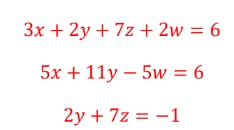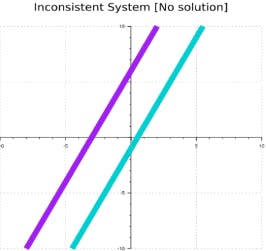A linear equation is simply an equation with no variable whose power is greater than 1. A linear equation is always a polynomial of degree 1.
Example of linear equation:

Example of nonlinear equation:

A system of linear equations is a collection of one or more linear equations. Example:

It is possible to solve this system using the elimination or substitution method, but it is also possible to do it with matrix operation. Before we start setting up matrices, it is important to remember that each equation in the system becomes a row, and each variable in the system becomes a column. The variables are dropped and the coefficients are placed into a matrix. If the right-hand side is included it is called an augmented matrix. if the right-hand side is not included, it’s called a coefficient matrix. An example would be better to understand :
Consider a linear system

The matrix

Is called the coefficient matrix of the given linear system and the matrix

is called the augmented matrix of the system.
Furthermore, three types of solutions are possible when solving a system of linear equations.
Every system of linear equations has no solutions, has exactly one solution, or has infinitely many solutions. Systems of equations fall into two categories: consistent systems and inconsistent systems. A system of equations that has no solution is said to be inconsistent, which is one in which the equations represent parallel lines.
Case-1 (inconsistent):

$$ 2x+3y=6, 4x+6y=5$$
Case-2 (consistent and one unique solution):
If there is at least one solution in the system, it is called consistent. A consistent system is considered to be an independent system if it has a single solution, such lines have different slopes and intersect at one particular point.

Case-3 (consistent and infinite number of solutions):
A consistent system is considered to be a dependent system if the lines coincide (overlap with each other) so the equations represent the same line. Every point on the line represents a coordinate that satisfies the system. Thus, there are an infinite number of solutions.

An arbitrary system of m linear equations in n unknowns can be written as:

where x1, x2.....xn, are the unknowns and the subscripted a's and b's denote constants.
